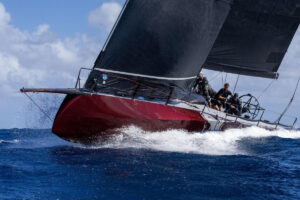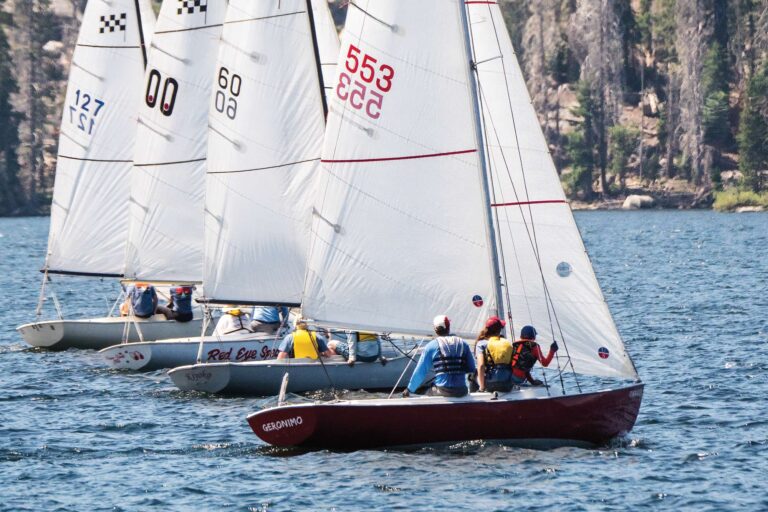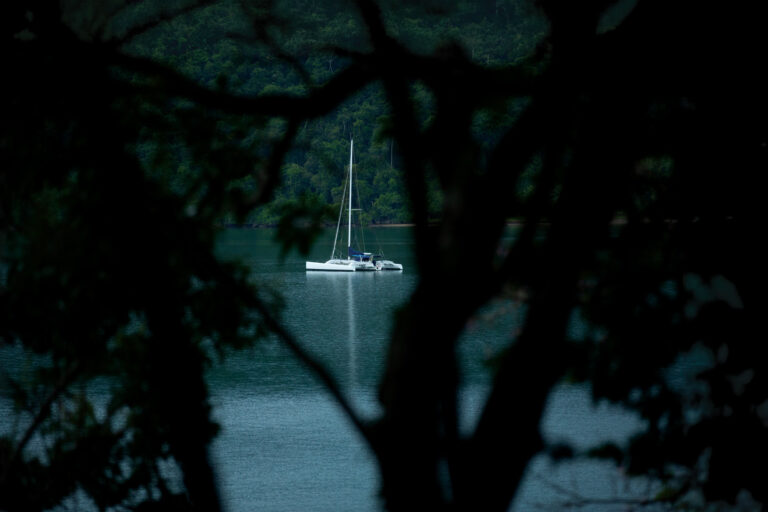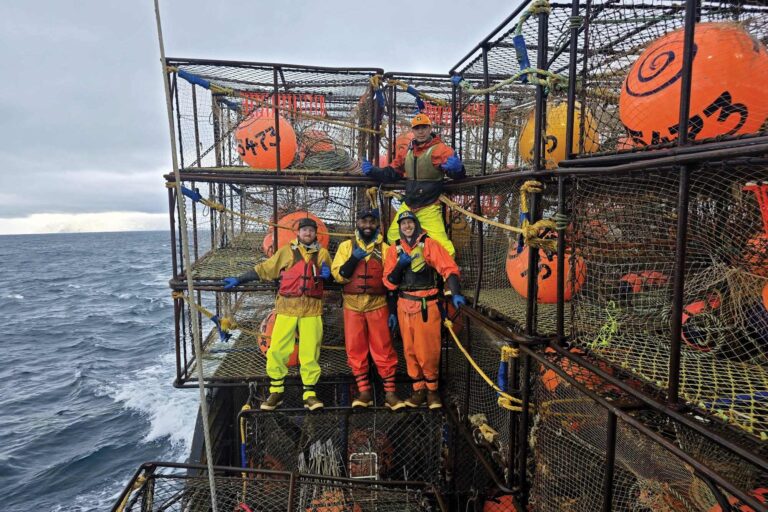
Bright sun penetrated the deep water near the rim of the volcano, and the water appeared a rich aqua behind my mask. I was snorkeling with my video camera in a waterproof housing and listening to the sound of my breathing. Aware of the others in our group, I was lagging behind, along the steep wall, trying to zoom in on some colorful reef fish. Then I heard the muffled call-“Shark!”-and surfaced to see my wife, Rachel, pointing just to my right. I ducked my head down again and pressed the “start” button: A moment later, a five-foot hammerhead glided toward me, about 20 feet below the surface, veering away from the wall a few seconds later and quickly fading out of sight. Strangely, I wasn’t scared. OK, I was wide awake, but I was mostly frustrated that the view was so brief. Not only did I want to see the hammerhead again, I realized; I actually wanted to get closer.
I’d landed barely 24 hours earlier, but I could already feel that when it came to getting nose to nose with the wildlife, the Galapagos could have a powerful effect on you.
In the past, if someone mentioned Ecuador’s Galapagos Islands to me, I’d think of giant tortoises fed upon by early seafarers; the voyage of Beagle and its famous passenger, Charles Darwin; and his book On the Origin of Species. Once I visited the islands, however, I was confronted not only by the stunning array of animal species but equally by the platform itself-this ecological laboratory-in reality a slow-moving train of volcanic islands that are working their way southeast at a rate of one inch per year.
My wife, Rachel Balaban, and I joined some CW readers on an Adventure Charter in the Galapagos last March, sailing aboard the 120-foot motorsailer Alta. In many ways, the seven-day tour was a fast-forward passage through time.
Each day, Alta anchored off at least one new island, and our guide, Jorge Garcia, took us hiking and snorkeling. We suffered from sensory and information overload, but took notes, photos, and video as fast as we could, trying to keep the boobies straight-male, female, juvenile, and nasca, red-footed and blue-footed. Sleep came easily each night, as Alta powered through the dark and mostly calm seas to the next island; by 0600, most of us were on deck drinking strong coffee and ready for another wide-eyed day of personal exploration.
Our CW Adventure Charter trip, hosted by Quasar Nautica, one of the better tour companies serving the islands, began with a flight from Miami to Guayaquil, Ecuador; then we took a Quasar charter flight 600 miles west to Isla San Cristobal, one of the oldest islands among the Galapagos. We loaded aboard Alta right away in Puerto Baquerizo Moreno, one of two developed ports in the islands, and were soon watching frigate birds soaring above Kicker Rock. We then hit a nearby beach to test our snorkel gear. Thirty-six hours later, we’d circumnavigated halfway ’round the islands and found ourselves hiking on the black lava rock of Isla Fernandina, one of the newest islands-about 500,000 years old. Still a work in progress, Fernandina erupted in 1998, 2000, 2002, and 2005 and has little vegetation. The rocks by the shore teemed with sea lions, flightless cormorants, brightly colored Sallie Lightfoot crabs, and marine iguanas (which swim at low tide to feed on algae and seaweed, then spend the rest of the day warming up again in the sun).
In the week that followed, we visited progressively older islands, such as neighboring Isabela, the million-year-old home to five volcanoes, and Isla Bartolome, which is an older, collapsed volcano bearing a passing resemblance to a moonscape. Eventually, on Santa Cruz, Española, and San Cristobal, the hard edges of the landscape softened, we found much more vegetation and precipitation, and more giant tortoises and land iguanas. Ironically, while the land is more hospitable to the animals on these older islands, they find more competition, too, from both animals and plants introduced to the islands over the last 300 to 400 years, as well as from the humans who have settled there.
Underwater Experience
Aboard Alta, we crossed the equator four times in our first four days, but the water wasn’t the bathtub temperature you might expect. Several ocean currents, both warm and cold, affect the archipelago, and although the fish are generally not as colorful as you’ll find in the tropical Caribbean waters, the nutrient-laden cold currents spawn an incredible diversity of species. We snorkeled every day but one, and we usually wore thin, shortie wetsuits, which made swimming quite comfortable.
During the swim at Isla Genovesa when we twice saw the hammerhead shark (yes, he came back and I got a few feet closer!), I also had the exquisite experience of drifting through the midst of a thick, colorful school of fish, which showed absolutely no concern for my presence. For a moment, despite my noisy breathing, I felt as if I were one of them.

A day later, a turtle swam by, several feet below me, seeming almost in slow motion. As I followed, he propelled himself along effortlessly, and it seemed as if he were in flight. Then he began to rise toward the surface and I had to quickly halt my forward progress, so I didn’t end up on his back.
The next day, we were introduced to the Galapagos penguin. We noticed a little fella hanging out on the rocks with the sea lions and periodically hopping into the water and swimming along the surface. When he spotted something to eat, in a flash he’d do a high-speed vertical dive and disappear into the depths.
As a budding Jacques Cousteau (armed with video camera), I often found my footage compromised by low light and slightly cloudy waters, plus the usual operator error (especially the time I closed the underwater housing before I removed the lens cap). But every dive was enjoyable, and one of my best video moments came on our last day at Isla Española. There, along a rocky wall for several minutes, an accommodating sea lion performed aquatic acrobatics for me.
Threats to the Islands
Ecuador’s National Park Service shot all the goats on Isla Isabela several years ago, successfully eliminating 200,0000 “non-endemic” animals. According to our guide, Jorge, the first goats were brought in by sailors and have made survival hard for endemic species such as the 7,000 giant tortoises with which they compete for food. Jorge said that males were tagged with sensors, which then made it easy to find and shoot large groups of females from helicopters. Not pretty, but effective.
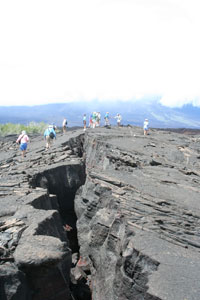
Nonetheless, the problem of “introduced” species continues to grow. According to the Galapagos Report 2006-2007, produced by two government agencies, more than half of the native plant and animal species are vulnerable or in some danger. Since 1990, the number of registered introduced species has grown from a little more than 100 to over 1,300.
Where do they come from? Well, at the airport, all of our luggage was screened. And every time we stepped aboard Alta, we hosed off our shoes and feet to avoid unintentionally transporting a tiny plant or animal from one island to the next. But the numbers tell the story: clearly humans are one of the most dangerous of “introduced” species in the archipelago. Since 2001, there’s been a 59-percent increase in air passengers (Galapagos Report 2006-2007). Despite a freeze on the number of tour boats, larger ships have increased capacity by 72 percent in the last 15 years, and hotel capacity has almost doubled. The Galapagos Report 2006-2007 says that the number of visitors has grown from 40,000 to 145,000 between 1990 and 2006. And supporting the increased tourism, the local population has grown from 4,000 in the early 1970s to roughly 30,000 today.
Another problem is illegal fishing. We were repeatedly reminded not to buy any souvenirs made with black coral, shells, and sea urchins. During our first walk around Isla Genovesa, Jorge spoke passionately about the Ecuadorian government’s lack of funding to protect the islands. The islands are 97 percent national park, and the waters are 100-percent marine reserve, but, he said, there’s only one government patrol boat for the entire reserve-and, as with many institutions in the islands, it relies on funds donated by such groups as the Galapagos Conservancy.
Jorge also said that the new president, Rafael Correa, recently decided to permit shark hunting elsewhere in Ecuador. Although shark hunting isn’t permitted in the Galapagos, Jorge said that illegal fishing in the marine reserve has increased now that there’s a market for shark.
Not about the sailing
We didn’t actually sail in the Galapagos. We covered 504 nautical miles but only had the sails drawing once-the engine was always turning over. With the distances we had to cover between the islands and the light airs of the warm and wet season (December to May), sailing would’ve been impractical. However, I won’t soon forget our late afternoon run from Isla Española back to San Cristobal; we motorsailed with Alta heeling slightly in about 10 knots of breeze while rays leaped high out of the water.
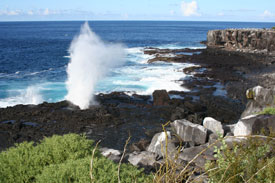
And because the animals were unafraid of humans, we saw a lot of sex. We saw male frigate birds inflating their red gulac sacs (throat bags) to attact females, gulls copulating on the beach and in the rocks; we even witnessed giant tortoises doing it in the mud. Not that it was a big deal; it just reinforced what evolution is all about.
Rachel and I read Jonathan Weiner’s The Beak of the Finch, about the life work of two biologists, Peter and Rosemary Grant, who focused on natural selection among Galapagos finches on the small island of Daphne Major. The Grants’ long-term studies, and others reported by Weiner, were a perfect complement to the week’s sights and sounds.
To minimize our impact, visitors to the Galapagos must be led by a registered guide. It adds to the cost, but a guide can be a wonderful teacher. On Alta, Jorge delivered a daily dose of knowledge, enthusiasm, and respect for the islands, not to mention his “sea-lion wakeup call” at 0540 on mornings when we were making an early start.
For one charterer, Barry Lowe, Jorge provided a tutorial in taking underwater photos. For George Greenberg, the owner of a just-launched Tartan, our guide delivered a detailed orientation for the Galapagos cruise George plans to make on his new boat.
The opportunity to discover the Galapagos was a chance to connect with the mysteries of all species, including my own. Wherever I sail, I’ll try to carry with me a greater awareness of being part of the natural order, not somehow separate. These islands are not my native habitat, and I hope, along with the rest of my kind, that I can help rather than hurt the survival chances of those species that evolved there in the first place.
John Burnham, former editor of Cruising World, is now content director of Rightboat.com

